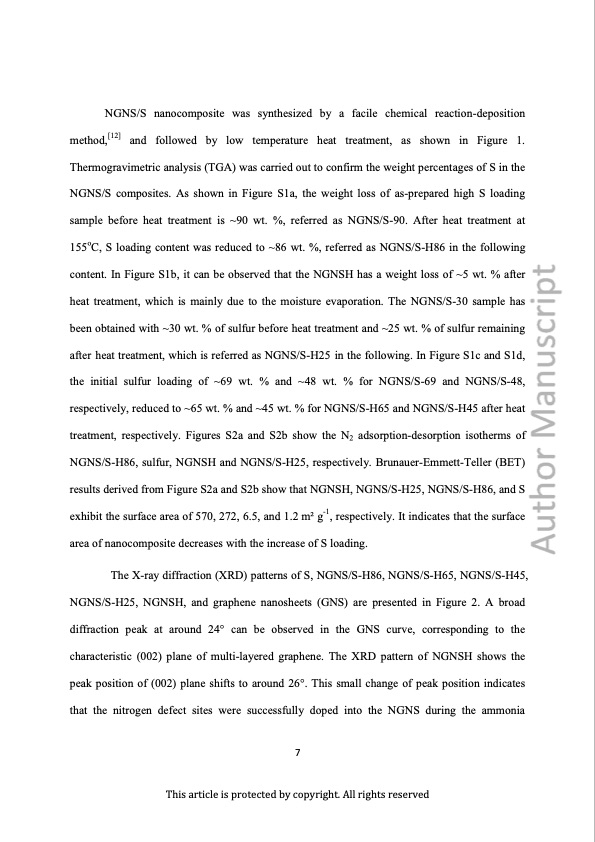
PDF Publication Title:
Text from PDF Page: 008
NGNS/S nanocomposite was synthesized by a facile chemical reaction-deposition method,[12] and followed by low temperature heat treatment, as shown in Figure 1. Thermogravimetric analysis (TGA) was carried out to confirm the weight percentages of S in the NGNS/S composites. As shown in Figure S1a, the weight loss of as-prepared high S loading sample before heat treatment is ~90 wt. %, referred as NGNS/S-90. After heat treatment at 155oC, S loading content was reduced to ~86 wt. %, referred as NGNS/S-H86 in the following content. In Figure S1b, it can be observed that the NGNSH has a weight loss of ~5 wt. % after heat treatment, which is mainly due to the moisture evaporation. The NGNS/S-30 sample has been obtained with ~30 wt. % of sulfur before heat treatment and ~25 wt. % of sulfur remaining after heat treatment, which is referred as NGNS/S-H25 in the following. In Figure S1c and S1d, the initial sulfur loading of ~69 wt. % and ~48 wt. % for NGNS/S-69 and NGNS/S-48, respectively, reduced to ~65 wt. % and ~45 wt. % for NGNS/S-H65 and NGNS/S-H45 after heat treatment, respectively. Figures S2a and S2b show the N2 adsorption-desorption isotherms of NGNS/S-H86, sulfur, NGNSH and NGNS/S-H25, respectively. Brunauer-Emmett-Teller (BET) results derived from Figure S2a and S2b show that NGNSH, NGNS/S-H25, NGNS/S-H86, and S exhibit the surface area of 570, 272, 6.5, and 1.2 m2 g-1, respectively. It indicates that the surface area of nanocomposite decreases with the increase of S loading. The X-ray diffraction (XRD) patterns of S, NGNS/S-H86, NGNS/S-H65, NGNS/S-H45, NGNS/S-H25, NGNSH, and graphene nanosheets (GNS) are presented in Figure 2. A broad diffraction peak at around 24° can be observed in the GNS curve, corresponding to the characteristic (002) plane of multi-layered graphene. The XRD pattern of NGNSH shows the peak position of (002) plane shifts to around 26°. This small change of peak position indicates that the nitrogen defect sites were successfully doped into the NGNS during the ammonia 7 This article is protected by copyright. All rights reservedPDF Image | Nitrogen-Doped Graphene Nanosheets Composites as Cathode in Sodium-Sulfur Batteries

PDF Search Title:
Nitrogen-Doped Graphene Nanosheets Composites as Cathode in Sodium-Sulfur BatteriesOriginal File Name Searched:
slct-201701951.pdfDIY PDF Search: Google It | Yahoo | Bing
Sulfur Deposition on Carbon Nanofibers using Supercritical CO2 Sulfur Deposition on Carbon Nanofibers using Supercritical CO2. Gamma sulfur also known as mother of pearl sulfur and nacreous sulfur... More Info
CO2 Organic Rankine Cycle Experimenter Platform The supercritical CO2 phase change system is both a heat pump and organic rankine cycle which can be used for those purposes and as a supercritical extractor for advanced subcritical and supercritical extraction technology. Uses include producing nanoparticles, precious metal CO2 extraction, lithium battery recycling, and other applications... More Info
| CONTACT TEL: 608-238-6001 Email: greg@infinityturbine.com | RSS | AMP |